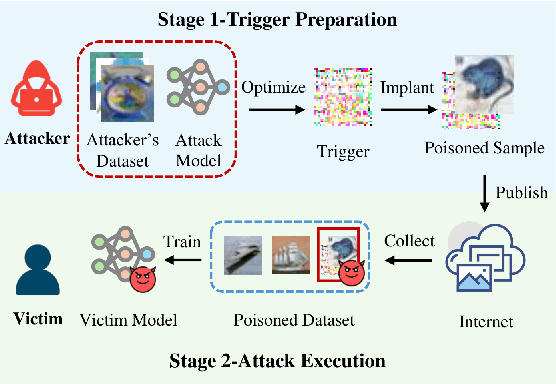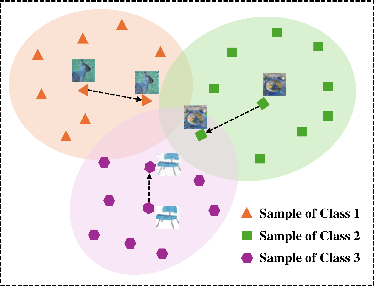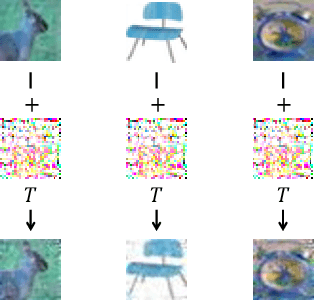Shouling Ji
NeuroBreak: Unveil Internal Jailbreak Mechanisms in Large Language Models
Sep 04, 2025Abstract:In deployment and application, large language models (LLMs) typically undergo safety alignment to prevent illegal and unethical outputs. However, the continuous advancement of jailbreak attack techniques, designed to bypass safety mechanisms with adversarial prompts, has placed increasing pressure on the security defenses of LLMs. Strengthening resistance to jailbreak attacks requires an in-depth understanding of the security mechanisms and vulnerabilities of LLMs. However, the vast number of parameters and complex structure of LLMs make analyzing security weaknesses from an internal perspective a challenging task. This paper presents NeuroBreak, a top-down jailbreak analysis system designed to analyze neuron-level safety mechanisms and mitigate vulnerabilities. We carefully design system requirements through collaboration with three experts in the field of AI security. The system provides a comprehensive analysis of various jailbreak attack methods. By incorporating layer-wise representation probing analysis, NeuroBreak offers a novel perspective on the model's decision-making process throughout its generation steps. Furthermore, the system supports the analysis of critical neurons from both semantic and functional perspectives, facilitating a deeper exploration of security mechanisms. We conduct quantitative evaluations and case studies to verify the effectiveness of our system, offering mechanistic insights for developing next-generation defense strategies against evolving jailbreak attacks.
TrojanTO: Action-Level Backdoor Attacks against Trajectory Optimization Models
Jun 15, 2025Abstract:Recent advances in Trajectory Optimization (TO) models have achieved remarkable success in offline reinforcement learning. However, their vulnerabilities against backdoor attacks are poorly understood. We find that existing backdoor attacks in reinforcement learning are based on reward manipulation, which are largely ineffective against the TO model due to its inherent sequence modeling nature. Moreover, the complexities introduced by high-dimensional action spaces further compound the challenge of action manipulation. To address these gaps, we propose TrojanTO, the first action-level backdoor attack against TO models. TrojanTO employs alternating training to enhance the connection between triggers and target actions for attack effectiveness. To improve attack stealth, it utilizes precise poisoning via trajectory filtering for normal performance and batch poisoning for trigger consistency. Extensive evaluations demonstrate that TrojanTO effectively implants backdoor attacks across diverse tasks and attack objectives with a low attack budget (0.3\% of trajectories). Furthermore, TrojanTO exhibits broad applicability to DT, GDT, and DC, underscoring its scalability across diverse TO model architectures.
TooBadRL: Trigger Optimization to Boost Effectiveness of Backdoor Attacks on Deep Reinforcement Learning
Jun 12, 2025Abstract:Deep reinforcement learning (DRL) has achieved remarkable success in a wide range of sequential decision-making domains, including robotics, healthcare, smart grids, and finance. Recent research demonstrates that attackers can efficiently exploit system vulnerabilities during the training phase to execute backdoor attacks, producing malicious actions when specific trigger patterns are present in the state observations. However, most existing backdoor attacks rely primarily on simplistic and heuristic trigger configurations, overlooking the potential efficacy of trigger optimization. To address this gap, we introduce TooBadRL (Trigger Optimization to Boost Effectiveness of Backdoor Attacks on DRL), the first framework to systematically optimize DRL backdoor triggers along three critical axes, i.e., temporal, spatial, and magnitude. Specifically, we first introduce a performance-aware adaptive freezing mechanism for injection timing. Then, we formulate dimension selection as a cooperative game, utilizing Shapley value analysis to identify the most influential state variable for the injection dimension. Furthermore, we propose a gradient-based adversarial procedure to optimize the injection magnitude under environment constraints. Evaluations on three mainstream DRL algorithms and nine benchmark tasks show that TooBadRL significantly improves attack success rates, while ensuring minimal degradation of normal task performance. These results highlight the previously underappreciated importance of principled trigger optimization in DRL backdoor attacks. The source code of TooBadRL can be found at https://github.com/S3IC-Lab/TooBadRL.
VModA: An Effective Framework for Adaptive NSFW Image Moderation
May 29, 2025Abstract:Not Safe/Suitable for Work (NSFW) content is rampant on social networks and poses serious harm to citizens, especially minors. Current detection methods mainly rely on deep learning-based image recognition and classification. However, NSFW images are now presented in increasingly sophisticated ways, often using image details and complex semantics to obscure their true nature or attract more views. Although still understandable to humans, these images often evade existing detection methods, posing a significant threat. Further complicating the issue, varying regulations across platforms and regions create additional challenges for effective moderation, leading to detection bias and reduced accuracy. To address this, we propose VModA, a general and effective framework that adapts to diverse moderation rules and handles complex, semantically rich NSFW content across categories. Experimental results show that VModA significantly outperforms existing methods, achieving up to a 54.3% accuracy improvement across NSFW types, including those with complex semantics. Further experiments demonstrate that our method exhibits strong adaptability across categories, scenarios, and base VLMs. We also identified inconsistent and controversial label samples in public NSFW benchmark datasets, re-annotated them, and submitted corrections to the original maintainers. Two datasets have confirmed the updates so far. Additionally, we evaluate VModA in real-world scenarios to demonstrate its practical effectiveness.
Poison in the Well: Feature Embedding Disruption in Backdoor Attacks
May 26, 2025



Abstract:Backdoor attacks embed malicious triggers into training data, enabling attackers to manipulate neural network behavior during inference while maintaining high accuracy on benign inputs. However, existing backdoor attacks face limitations manifesting in excessive reliance on training data, poor stealth, and instability, which hinder their effectiveness in real-world applications. Therefore, this paper introduces ShadowPrint, a versatile backdoor attack that targets feature embeddings within neural networks to achieve high ASRs and stealthiness. Unlike traditional approaches, ShadowPrint reduces reliance on training data access and operates effectively with exceedingly low poison rates (as low as 0.01%). It leverages a clustering-based optimization strategy to align feature embeddings, ensuring robust performance across diverse scenarios while maintaining stability and stealth. Extensive evaluations demonstrate that ShadowPrint achieves superior ASR (up to 100%), steady CA (with decay no more than 1% in most cases), and low DDR (averaging below 5%) across both clean-label and dirty-label settings, and with poison rates ranging from as low as 0.01% to 0.05%, setting a new standard for backdoor attack capabilities and emphasizing the need for advanced defense strategies focused on feature space manipulations.
On the Security Risks of ML-based Malware Detection Systems: A Survey
May 16, 2025Abstract:Malware presents a persistent threat to user privacy and data integrity. To combat this, machine learning-based (ML-based) malware detection (MD) systems have been developed. However, these systems have increasingly been attacked in recent years, undermining their effectiveness in practice. While the security risks associated with ML-based MD systems have garnered considerable attention, the majority of prior works is limited to adversarial malware examples, lacking a comprehensive analysis of practical security risks. This paper addresses this gap by utilizing the CIA principles to define the scope of security risks. We then deconstruct ML-based MD systems into distinct operational stages, thus developing a stage-based taxonomy. Utilizing this taxonomy, we summarize the technical progress and discuss the gaps in the attack and defense proposals related to the ML-based MD systems within each stage. Subsequently, we conduct two case studies, using both inter-stage and intra-stage analyses according to the stage-based taxonomy to provide new empirical insights. Based on these analyses and insights, we suggest potential future directions from both inter-stage and intra-stage perspectives.
Dyn-D$^2$P: Dynamic Differentially Private Decentralized Learning with Provable Utility Guarantee
May 10, 2025Abstract:Most existing decentralized learning methods with differential privacy (DP) guarantee rely on constant gradient clipping bounds and fixed-level DP Gaussian noises for each node throughout the training process, leading to a significant accuracy degradation compared to non-private counterparts. In this paper, we propose a new Dynamic Differentially Private Decentralized learning approach (termed Dyn-D$^2$P) tailored for general time-varying directed networks. Leveraging the Gaussian DP (GDP) framework for privacy accounting, Dyn-D$^2$P dynamically adjusts gradient clipping bounds and noise levels based on gradient convergence. This proposed dynamic noise strategy enables us to enhance model accuracy while preserving the total privacy budget. Extensive experiments on benchmark datasets demonstrate the superiority of Dyn-D$^2$P over its counterparts employing fixed-level noises, especially under strong privacy guarantees. Furthermore, we provide a provable utility bound for Dyn-D$^2$P that establishes an explicit dependency on network-related parameters, with a scaling factor of $1/\sqrt{n}$ in terms of the number of nodes $n$ up to a bias error term induced by gradient clipping. To our knowledge, this is the first model utility analysis for differentially private decentralized non-convex optimization with dynamic gradient clipping bounds and noise levels.
ArtistAuditor: Auditing Artist Style Pirate in Text-to-Image Generation Models
Apr 17, 2025Abstract:Text-to-image models based on diffusion processes, such as DALL-E, Stable Diffusion, and Midjourney, are capable of transforming texts into detailed images and have widespread applications in art and design. As such, amateur users can easily imitate professional-level paintings by collecting an artist's work and fine-tuning the model, leading to concerns about artworks' copyright infringement. To tackle these issues, previous studies either add visually imperceptible perturbation to the artwork to change its underlying styles (perturbation-based methods) or embed post-training detectable watermarks in the artwork (watermark-based methods). However, when the artwork or the model has been published online, i.e., modification to the original artwork or model retraining is not feasible, these strategies might not be viable. To this end, we propose a novel method for data-use auditing in the text-to-image generation model. The general idea of ArtistAuditor is to identify if a suspicious model has been finetuned using the artworks of specific artists by analyzing the features related to the style. Concretely, ArtistAuditor employs a style extractor to obtain the multi-granularity style representations and treats artworks as samplings of an artist's style. Then, ArtistAuditor queries a trained discriminator to gain the auditing decisions. The experimental results on six combinations of models and datasets show that ArtistAuditor can achieve high AUC values (> 0.937). By studying ArtistAuditor's transferability and core modules, we provide valuable insights into the practical implementation. Finally, we demonstrate the effectiveness of ArtistAuditor in real-world cases by an online platform Scenario. ArtistAuditor is open-sourced at https://github.com/Jozenn/ArtistAuditor.
UNIDOOR: A Universal Framework for Action-Level Backdoor Attacks in Deep Reinforcement Learning
Jan 26, 2025



Abstract:Deep reinforcement learning (DRL) is widely applied to safety-critical decision-making scenarios. However, DRL is vulnerable to backdoor attacks, especially action-level backdoors, which pose significant threats through precise manipulation and flexible activation, risking outcomes like vehicle collisions or drone crashes. The key distinction of action-level backdoors lies in the utilization of the backdoor reward function to associate triggers with target actions. Nevertheless, existing studies typically rely on backdoor reward functions with fixed values or conditional flipping, which lack universality across diverse DRL tasks and backdoor designs, resulting in fluctuations or even failure in practice. This paper proposes the first universal action-level backdoor attack framework, called UNIDOOR, which enables adaptive exploration of backdoor reward functions through performance monitoring, eliminating the reliance on expert knowledge and grid search. We highlight that action tampering serves as a crucial component of action-level backdoor attacks in continuous action scenarios, as it addresses attack failures caused by low-frequency target actions. Extensive evaluations demonstrate that UNIDOOR significantly enhances the attack performance of action-level backdoors, showcasing its universality across diverse attack scenarios, including single/multiple agents, single/multiple backdoors, discrete/continuous action spaces, and sparse/dense reward signals. Furthermore, visualization results encompassing state distribution, neuron activation, and animations demonstrate the stealthiness of UNIDOOR. The source code of UNIDOOR can be found at https://github.com/maoubo/UNIDOOR.
Defending against Adversarial Malware Attacks on ML-based Android Malware Detection Systems
Jan 23, 2025Abstract:Android malware presents a persistent threat to users' privacy and data integrity. To combat this, researchers have proposed machine learning-based (ML-based) Android malware detection (AMD) systems. However, adversarial Android malware attacks compromise the detection integrity of the ML-based AMD systems, raising significant concerns. Existing defenses against adversarial Android malware provide protections against feature space attacks which generate adversarial feature vectors only, leaving protection against realistic threats from problem space attacks which generate real adversarial malware an open problem. In this paper, we address this gap by proposing ADD, a practical adversarial Android malware defense framework designed as a plug-in to enhance the adversarial robustness of the ML-based AMD systems against problem space attacks. Our extensive evaluation across various ML-based AMD systems demonstrates that ADD is effective against state-of-the-art problem space adversarial Android malware attacks. Additionally, ADD shows the defense effectiveness in enhancing the adversarial robustness of real-world antivirus solutions.
 Add to Chrome
Add to Chrome Add to Firefox
Add to Firefox Add to Edge
Add to Edge